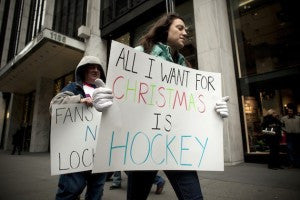This is a guest post from Brandon Steiner, the CEO of Steiner Sports and the author of this fantastically-named book.
Last week, we learned that the NHL cancelled all games through December 14, in addition to the All-Star game, due to the current lockout between the league and the players’ association. It’s a messy situation, and the window in which it can be (somewhat) rectified is getting increasingly smaller.
According to my calculations, the NHL has about four more days in which the two sides can hammer out a deal and still play a 60-game season (the bare minimum for legitimacy) plus playoffs. Starting the season over four days from now would lead to it possibly running into July, which is infeasible for a number of reasons, not the least of which is that you’d have a hard time finding a playoff hockey audience during the summer, with the baseball and summer travel seasons in full swing.
In a statement made November 24th, NHLPA executive director Donald Fehr said the gap between the two sides on “core economic issues is $182 million,” which is roughly the amount of money the league loses every 10 days there’s no hockey being played. 10 days. So clearly, the two sides are capable of fighting over a pack of tic-tacs. I’m not sure more profits would help prevent future lockouts.
But it couldn’t hurt, and with hockey on hiatus, this might be a good time to consider these four revenue enhancements:
1. Lose some seats, gain some ice.
Before 2010, when the Olympics switched to using NHL-sized rinks, Olympic hockey made us feel like the NHL games we had been watching were being played inside sardine trays. We loved Olympic hockey partly because the rink was bigger, which allowed for smoother, more graceful play (197 x 98.4 ft. compared to 200 x 85 ft.). The NHL should remove some first-row seats from its arenas in order to expand the size of the ice. Yeah, you might lose a little revenue, but the style of hockey will improve, leading to more eyeballs, leading to more revenue in the long run.
2. Reduce the size of the goalie’s pads.
I realize the league has already taken some steps in this direction, but guess what – it can afford to take a few more. People like to joke about putting a sumo wrestler between the pipes; sometimes I look at all the padding goalies wear, and I wonder what the difference is. They take up a lot of space. Keep those guys protected, while leaving the net a little more vulnerable: they should look more like baseball catchers than pituitary cases.
3. Give each team a real timeout.
Did you know each side in a NHL game only gets one 30-second timeout, and it has to be taken after play has already been stopped? I realize a major appeal of hockey is that it’s fast-paced, with breakneck player substitutions, but c’mon – this is a pro sport. We don’t need to squeeze each game into that tight of a window. Give each team one, honest-to-God timeout per game, with which it can stop the action, substitute the right players, and then run some kind of set play. This will only increase the quality of the product.
. Make the helmets cooler.
The helmets are so boring the way they are: all one color with a little team decal. If you’re watching a game on TV, these are the things you see the most of. So: take a cue from the goalies, and make them cooler-looking.
The founder & CEO of Steiner Sports Marketing & Memorabilia, Brandon Steiner is also an author and inspirational speaker. Buy his latest book, You Gotta Have Balls, here. Follow his thoughts for free by visiting his blog, Facebook, or Twitter page.


